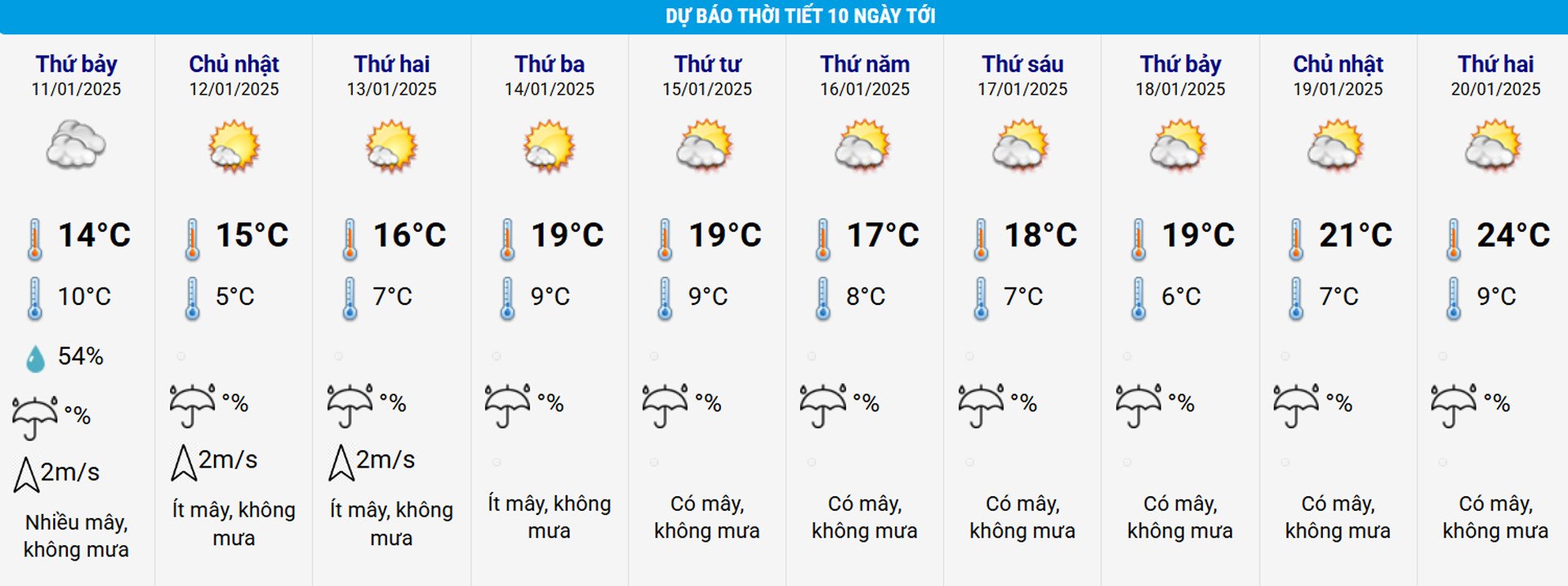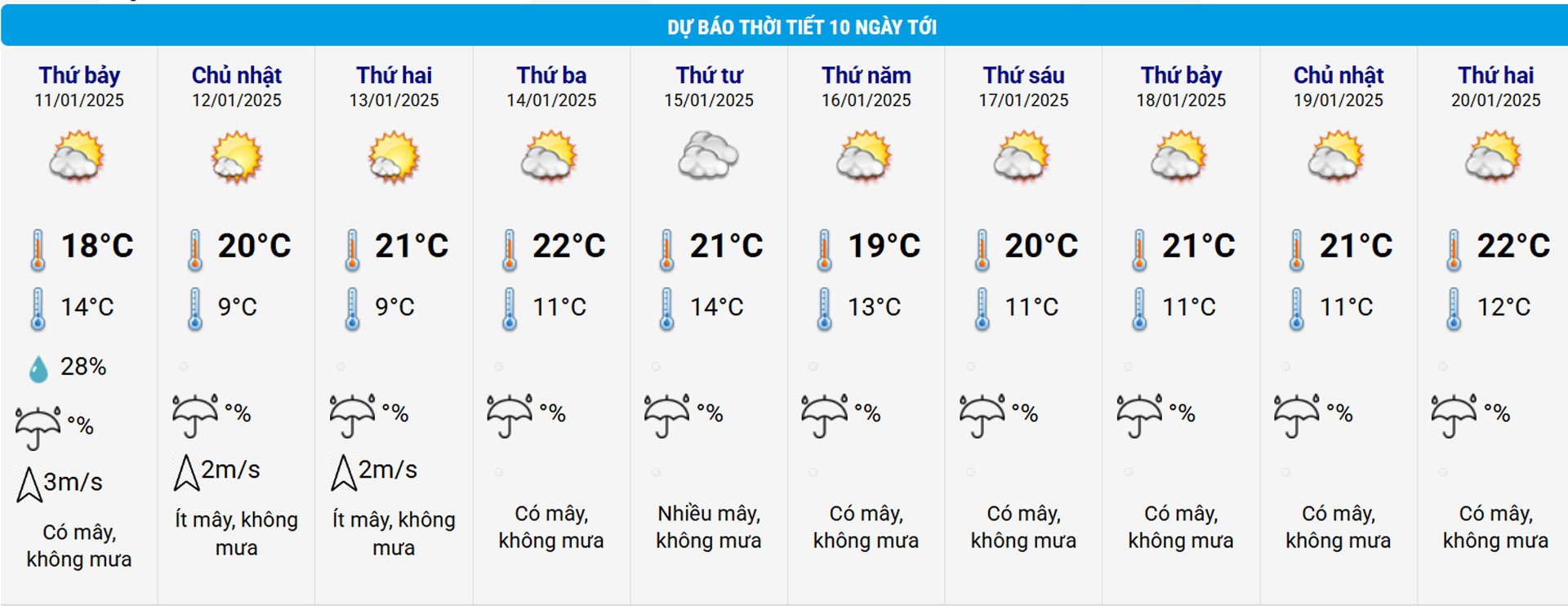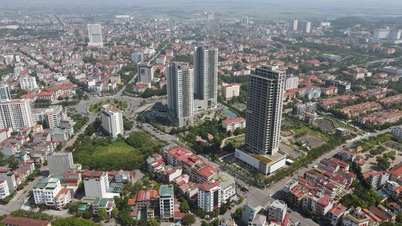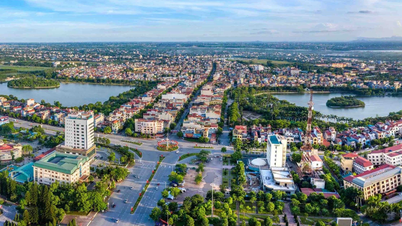Mr. Nguyen Van Huong, Head of Weather Forecast Department, National Center for Hydro-Meteorological Forecasting, said that the cold air will have the strongest impact in the afternoon and night of January 10 to January 12.
“During this period, we forecast that mountainous areas and the midlands of the North will likely experience severe cold, with some areas experiencing severe cold. Frost and frost on high mountain peaks such as Fansipan and Mau Son are also likely to occur,” Mr. Huong said.
According to Mr. Huong, severe cold is when the average daily temperature is below 15 degrees, and severe cold is when it is below 13 degrees.

According to the National Center for Hydro-Meteorological Forecasting, this afternoon (January 10), cold air has affected the Northwestern provinces and some places in the Central Central region; in the Gulf of Tonkin, there are strong Northeast winds of level 7, gusting to level 9.
This evening and tonight, the cold air continues to strengthen and affect other places in the Central Central region and some places in the South Central region. The Northeast wind inland is strong at level 3, coastal areas at level 3-4, with some places having gusts of level 6.

Due to the influence of the strong cold air, from the night of January 10-13, in the North and the Thanh Hoa - Nghe An area, the weather will be very cold, especially in the mountainous and midland areas of the North, the weather will be very cold; in the area from Ha Tinh to Quang Ngai, the weather will be very cold.
The lowest temperature in this cold air mass in the North and Thanh Hoa - Nghe An region is generally 9-12 degrees, in the mountainous areas of the North 6-9 degrees, in the high mountainous areas below 3 degrees; in the Ha Tinh - Quang Binh region it is generally 13-16 degrees; in the area from Quang Tri to Quang Ngai 15-18 degrees.

According to Mr. Huong, the lowest temperature in the Hanoi area occurs from the night of January 10 to the night of January 11-12 at 9-12 degrees.
In addition, Mr. Huong informed that this cold air mass does not combine with the high-altitude easterly wind zone, so the Central region will have rain but the rainfall will be at an average level. The rain will mainly be concentrated in the area from Ha Tinh to Binh Dinh from January 10-11.
In particular, Mr. Huong noted that severe cold accompanied by frost and frost often occurs in the winter months - January and February. These phenomena have a very negative impact on crops and livestock. People, especially in mountainous areas, need to pay attention to caring for livestock and protecting crops.
Cold weather also affects health, especially the elderly and children, so we need to take measures to keep warm.
According to experts, the cold spell in the North is likely to be the coldest since the beginning of winter, when temperatures across the region will drop below 10 degrees, around early Sunday morning, January 12.
Previously, cold air masses were often not as strong as forecast due to the influence of many meteorological and geographical factors, so this Sunday morning can be considered the coldest time since the beginning of the season, on average across the North.
Then, from around January 13, the temperature across the region gradually increased, and by January 14-15, the possibility of a cold spell was strengthened.

Weather forecast for the next 10 days: Cold air continues to come, the North will be very cold
Weather forecast for the next 10 days (January 10-20), cold air will continuously strengthen, in which, around January 10-12, the temperature will drop the most with a level below 5 degrees in mountainous areas, with the possibility of frost. Localized heavy rain in the Central region.

Cold air is constantly added, what day is the coldest in the North?
Around noon on January 9, cold air began to flow into our country and then continuously replenished. It is forecasted that from the night of January 10 to 12, the North will experience severe cold, with the possibility of frost and frost in mountainous areas.




![[Photo] Readers line up to visit the photo exhibition and receive a special publication commemorating the 135th birthday of President Ho Chi Minh at Nhan Dan Newspaper](https://vphoto.vietnam.vn/thumb/1200x675/vietnam/resource/IMAGE/2025/5/17/85b3197fc6bd43e6a9ee4db15101005b)


![[Photo] Nearly 3,000 students moved by stories about soldiers](https://vphoto.vietnam.vn/thumb/1200x675/vietnam/resource/IMAGE/2025/5/17/21da57c8241e42438b423eaa37215e0e)











![[Infographic] Numbers about the 2025 High School Graduation Exam in Dong Thap Province](https://vphoto.vietnam.vn/thumb/402x226/vietnam/resource/IMAGE/2025/5/17/c6e481df97c94ff28d740cc2f26ebbdc)














































































Comment (0)